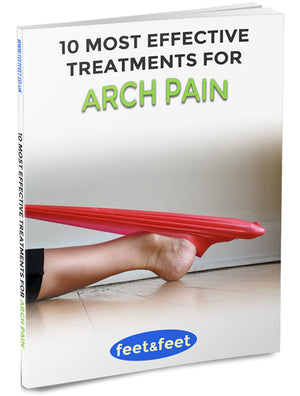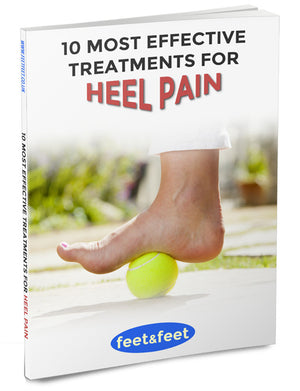How to Heal Plantar Fasciitis Quickly

The most common cause of heel pain is known as plantar fasciitis. It can cause pain and discomfort after periods of activity as well as inactivity. By taking sensible measures you can learn how to heal plantar fasciitis quickly and relieve yourself of chronic heel pain which can potentially hinder your everyday activities.
The plantar fascia is a thick and fibrous band of collagen fibres which exist on the sole of your foot. Its purpose is to support the arch of the foot and distribute pressure evenly across the foot as you move.
Plantar fasciitis is a condition which can develop when too much strain is placed on the plantar fascia; this is usually from overuse or repetitive actions which can cause small tears to develop in the collagen fibres. As a result, the sole of the foot can become swollen and inflamed.
If you want to quickly relieve the pain in your heels and arches so you can live your life normally again, then read our tips below on how to heal plantar fasciitis quickly.
5 Best Methods to Heal Plantar Fasciitis Quickly
Fortunately, the plantar fasciitis can easily be treated and studies have shown that the sooner treatment is started, the quicker the recovery process will be. By following these tips, you can begin to heal your plantar fasciitis quickly.
1. Rest, Ice and Massage
Experts recommend that if plantar fasciitis is caused by an injury, you should immediately elevate the affected foot and apply an ice pack for at least twenty minutes, 2 to 4 times a day. Once the swelling has subsided – which can take up to two days – you should do a regular daily massage on the heel with essential oils which can assist in reducing inflammation.
Warm oil massages are advantageous as they can increase blood circulation, speed up the healing process and break up any scar tissue or adhesions which could later harden.
2. Alter Your Activity Levels
By taking time off from the repetitive and high impact movements which can trigger the condition and are causing pain, you can give the affected plantar fasciitis tissue a chance to heal. Low impact sports such as cycling and swimming should not cause any pain to your feet.
If your heel pain is low to moderate, you can still perform simple stretching and strengthening exercises to improve the flexibility and strength of the plantar fascia tissue.
3. Wear the Appropriate Footwear
Wearing footwear – or inserting supportive insoles – that have excellent arch support and shock absorption will reduce the pressure put onto the heel. Athletic shoes which have a well cushioned sole are often a good choice which seems to work for most people.
You can also try orthotics (shoe inserts) to cushion your foot better; it is recommended that you use them in both shoes even if you are only suffering from pain in one foot.

4. Stretching Exercises
By regularly stretching the sole of your foot and your calf muscles, you can improve your condition and reduce the chances of plantar fasciitis developing again in the future. Stretching exercises can help to relieve the tightness felt in the plantar fascia tissue area, in the calf muscles and Achilles tendons.
Some of the most popular plantar fasciitis stretches are:
- Towel Stretch – You can perform this easy stretch while you’re seated on the floor or on the bed. Simply put both feet together and straighten out your legs, then place a rolled up towel on the balls of your feet, grab both ends of the towel and gently pull it back (while keeping your knees straight) until you feel your arch stretching. Hold this position for around 30 seconds and repeat.
- Toe Stretch – While seated, place your heel on the floor with your toes pointing upwards. Pull your big toe towards you until you feel the stretch in your foot arch, and hole this position for 30 seconds and then repeat.
5. Strengthening Exercises
Research has found that strengthening exercises such as slow, weighted heel raises offers more relief within three months than in those patients who used stretching exercises alone. There is a belief that strengthening exercises can increase the collagen production and the Achilles tendons ability to handle weight.
Some of the most popular plantar fasciitis strengthening exercises are:
Heel Raises – This stretch strengthens the calf muscles which minimises the development of plantar fasciitis. To perform a heel raise, stand with both feet together and simply raise your heels off the ground by pushing off the balls of your feet. Hold this position for 5-10 seconds and lower your heels. If you need help with your stability, find something stable to hold onto.
Towel Scrunch – Place a towel on the floor and put your foot flat on top of it while in a seated position. Using your toes, pull the towel towards yourself while still keeping your heels firmly on the ground. Release the towel and repeat.
Additional Tips
- Weight Loss – Excess body weight can be the cause of extra stress on the plantar fascia, which means that being overweight or obese play a role in the development of the condition. An activity such as swimming can be a good choice for weight loss as it does not put any stress on your feet.
- Changing the way that you walk in order to minimise the associated pain of plantar fasciitis is actually more harmful for your health. This is because this can lead to further knee, hip and back related problems.
It is estimated that up to 90% of people who have plantar fasciitis will improve significantly within two months of their initial treatment – this is especially true if they have included regular stretches and exercises.
To learn more about how to heal plantar fasciitis quickly, you can speak to a podiatrist or a physiotherapist who can offer you further advice and a custom treatment plan based on how severe your condition is.
Common Questions For Plantar Fasciitis Treatment
The frustrations and pain that occurs when dealing with plantar fasciitis often leaves people feeling impatient, hopeless and wanting answers. Here are some of the most common questions from people suffering from plantar fasciitis.
How quickly can pain be relieved?
The recovery time for plantar fasciitis can take anywhere from a few days in the best cases to a few years depending on how severe your condition is and how soon you begin treatment.
Of course, leaving your condition untreated or even undergoing the wrong type of treatment can prolong recovery times.
It also doesn’t help that everyone needs to use their feet on a daily basis which adds pressure and stress on the feet, reducing much needed resting times.
Someone with moderate plantar fasciitis who begins early treatment and takes the right precautions – such as wearing the right type of footwear, resting the feet frequently and being in good health – can recover in several weeks to months.
Is there a cure for plantar fasciitis?
While there is no immediate cure for plantar fasciitis yet, your feet can be healed in a short space of time either through natural treatment and care or from surgery and steroid injections; the latter two carrying some risks.
Painkillers can also provide some immediate pain relief while your plantar fascia is healing, but it doesn’t cure it, instead it masks the symptoms.
What are the most effective products to treat plantar fasciitis?
There is a wide range of different products that are used for treating plantar fasciitis. The most popular include:
- Plantar Fasciitis Insoles
- Plantar Fasciitis Inserts
- Heel Pads and Heel Cups
- Splints and Braces
- Footwear
- Custom Orthotics
Their prices can vary drastically and their level of effectiveness largely depends on the severity of the user’s condition and the quality of the product. Having said that, at least one or more of these products will be essential for the successful recovery for your plantar fasciitis.





Comments
Leave a comment